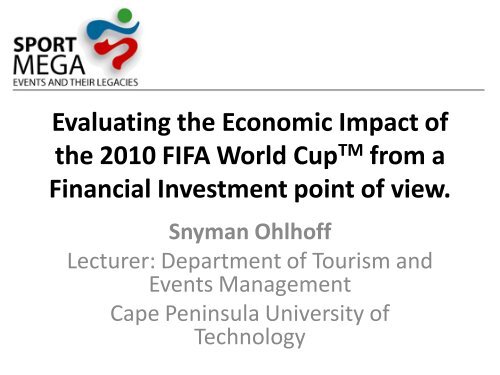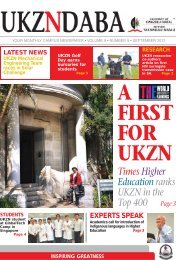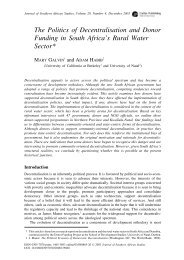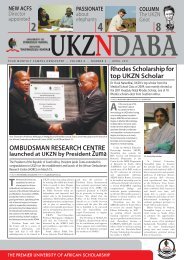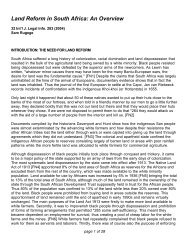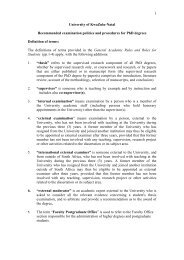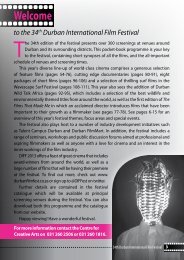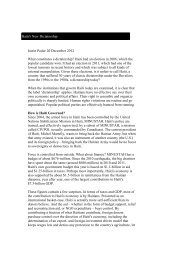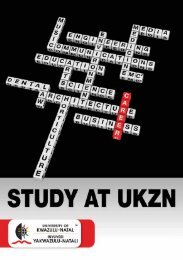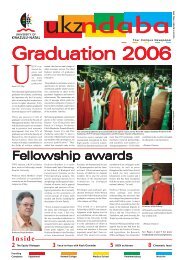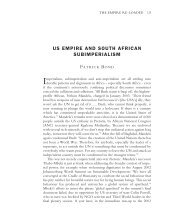Evaluating the Economic Impact of the 2010 FIFA World Cup from a ...
Evaluating the Economic Impact of the 2010 FIFA World Cup from a ...
Evaluating the Economic Impact of the 2010 FIFA World Cup from a ...
You also want an ePaper? Increase the reach of your titles
YUMPU automatically turns print PDFs into web optimized ePapers that Google loves.
<strong>Evaluating</strong> <strong>the</strong> <strong>Economic</strong> <strong>Impact</strong> <strong>of</strong><strong>the</strong> <strong>2010</strong> <strong>FIFA</strong> <strong>World</strong> <strong>Cup</strong> TM <strong>from</strong> aFinancial Investment point <strong>of</strong> view.Snyman Ohlh<strong>of</strong>fLecturer: Department <strong>of</strong> Tourism andEvents ManagementCape Peninsula University <strong>of</strong>Technology
IntroductionTitle <strong>of</strong> presentation is perhaps not completely accurate. The concept, aswas perhaps clarified in <strong>the</strong> abstract, is to consider <strong>the</strong> <strong>2010</strong> <strong>FIFA</strong> <strong>World</strong><strong>Cup</strong> TM specific investments and projected <strong>2010</strong> <strong>FIFA</strong> <strong>World</strong> <strong>Cup</strong> specificincome, as well as <strong>the</strong> time value <strong>of</strong> money to determine whe<strong>the</strong>r or not<strong>the</strong> investment decision would yield a positive net present value.It has however proved problematic to obtain <strong>the</strong> required data to complete<strong>the</strong>se calculations. Fur<strong>the</strong>r research in terms <strong>of</strong> appropriate methods toestimate <strong>the</strong> figures required is essential since <strong>the</strong> <strong>the</strong>oretical basis forestimations used here have not been examined.This presentation has <strong>the</strong>refore become more <strong>of</strong> a “work in progress” than<strong>the</strong> final product.
<strong>2010</strong> <strong>Economic</strong> impact studiesMost evaluations <strong>of</strong> <strong>the</strong> economic impact <strong>of</strong> <strong>the</strong> <strong>2010</strong> <strong>FIFA</strong> <strong>World</strong><strong>Cup</strong> TM (Bohlman & Van Heerden, 2005; Meannig & Du Plessis,2007; Campbell & Phago, 2008; Grant Thornton, 2008; Mabugu& Mohamed, 2008; Saayman & Rossouw, 2008) refer to results<strong>of</strong> sophisticated econometric models and focus on traditionalmacroeconomic indicators, such as overall impact on <strong>the</strong> GDP,employment, etc.Most predict a positive outlook, however with reservations andcaution.Meannig & Du Plessis (2007:583) specifically refer to <strong>the</strong> fact thatfew ex post studies report significant positive economic impacts.
Overview <strong>of</strong> some figures2008 Update 2007 Update Bid BookTotal Direct Spend Total Direct Spend Total Direct SpendRm Rm RmTicket sales 6 000 4 600 4 660O<strong>the</strong>r event expenditure 132 93 76Spectator trip expenditure 8 163 6 894 4 466Team trip expenditure 176 161 161Press & VIP trip spend 440 391 290Sponsorship and rights spend 756 756 756Infrastructure & stadium spend 17 400 17 400 2 304TOTAL SPEND 33 068 30 356 12 713GDP Contribution 55 714 51 144 21 419Employment Generated 415 400 381 327 159 697Tax income to government 19 390 17 800 7 245Source: Grant Thornton. 2008. The Business <strong>of</strong> <strong>2010</strong>, How <strong>the</strong> Numbers AddUp. Media Briefing, 21 November 2008.
The difference in approachAs mentioned above, <strong>the</strong> suggested overall impact on SouthAfrica’s GDP according to <strong>the</strong> latest estimates is in <strong>the</strong> order <strong>of</strong>R55,7bn (Grant Thornton, 2008).Of course this includes <strong>the</strong> approximately R17,4bn ininfrastructure and stadium investment directly related to <strong>the</strong><strong>World</strong> <strong>Cup</strong> (Grant Thornton, 2008), which <strong>the</strong> government ismaking.The question is, how much is <strong>the</strong> government earning for <strong>the</strong>direct investment in direct returns?To illustrate <strong>the</strong> difference in approach in a humorous way,consider <strong>the</strong> following.
<strong>Economic</strong>s vs. Financial ManagementAn economist and a financial manager are walking along a large puddle. They getacross a frog jumping on <strong>the</strong> mud. The economist says to his colleague: 'If youeat <strong>the</strong> frog I'll give you $20,000!’The accountant checks his budget and figures out he's better <strong>of</strong>f eating it, so hedoes and collects money.Continuing along <strong>the</strong> same puddle <strong>the</strong>y almost step into yet ano<strong>the</strong>r frog. Thefinancial manager says to <strong>the</strong> economist: 'Now, if you eat this frog I'll give you$20,000.'After evaluating <strong>the</strong> proposal <strong>the</strong> economist eats <strong>the</strong> frog and gets <strong>the</strong> money.They go on. The financial manager starts thinking: 'Listen, we both have <strong>the</strong> sameamount <strong>of</strong> money we had before, but we both ate frogs. I don't see us beingbetter <strong>of</strong>f. ’The economist: 'Well, that's true, but you overlooked <strong>the</strong> fact that we've been justinvolved in $40,000 <strong>of</strong> trade.’(Adapted <strong>from</strong> Stiver, n.d.)
Discounted Cash Flow TheoryCan be traced back as far as <strong>the</strong> Old Balylonian period <strong>of</strong> 1800 – 1600 B.C.(Parker, 1968: 58-71, as cited by Schrieves & Wachowicz, 2001:33).Leonardo Fibonacci, well known for <strong>the</strong> so-called Fibonacci sequence ornumbers, helped to introduce <strong>the</strong> calculation <strong>of</strong> interest (along withArabic numerals) to Europe in his book <strong>the</strong> Liber Abaci (1202)(Gies,2008).More modern works with additional conceptual insights include Fisher(1930, as cited by Schrieves & Wachowicz, 2001:33) and Hirshlerter(1958, 1970, as cited by Schrieves & Wachowicz, 2001:33).As such it is entrenched in accounting and business <strong>the</strong>ory.The concept <strong>of</strong> <strong>the</strong> use <strong>of</strong> capital budgeting techniques by government andnon-pr<strong>of</strong>it organisations is not unique and has received some attentionin <strong>the</strong> literature (Chan, 2004; Phillips, 2003).
Variables & FormulaDiscounted cash flow (DCF) valuation compares a series <strong>of</strong> cash flows over multipleperiods to calculate a present value (in most cases referred to as net present value)by discounting <strong>the</strong> future cash flows by a given discount rate to an equivalentpresent value . It is <strong>of</strong>ten used to compare two alternative investment options.The basic formula (Carmicheal & Balabat, 2008:86) is as follows:Let X be <strong>the</strong> cash flows for periods i= 1,2,3,…,n and let r be <strong>the</strong> discount rate. Thepresent value for an n-period investment PV n is given bynPV n = ∑i = 0X i(1+r) iInvestments that result in a positive (or <strong>the</strong> highest in comparison to o<strong>the</strong>r options)Net Prevent Value (NPV) are considered to be investments that should be made.
ChallengesSome <strong>of</strong> <strong>the</strong> periods have already elapsed (if <strong>the</strong> bid year is <strong>the</strong> starting point)- subsequently some <strong>of</strong> <strong>the</strong> cash flows (outflows) have already occurred.Ano<strong>the</strong>r question is <strong>the</strong> time horizon.Bid was in 2005Projected additional tourist arrival projections extend only to 2015Isolating investments and revenues which will be received by government asa result <strong>of</strong> <strong>the</strong> <strong>World</strong> <strong>Cup</strong> is a major challenge.Most available estimates (Meannig & Du Plessis, 2007; Grant Thornton, 2008)only provide single figures or percentage increases (Mabugu & Mohamed,2008) and do not indicate how outflows and inflows are spread overperiods.
Deciding on a starting pointShould calculation start <strong>from</strong> 2005?Current figure for investments <strong>of</strong> stadium and infrastructure related directlyto <strong>2010</strong>: R17,4bn (Grant Thornton, 2008)Bid book amount: ± R2.3bn (Grant Thornton, 2008).Clearly it was grossly underestimated at <strong>the</strong> time.Should we (unfairly) use <strong>the</strong> benefit <strong>of</strong> hindsight ?Perhaps a practical solution is to treat <strong>the</strong> investments already made as alump sum and take 2009 as period 0. A “retroactive” calculation willhowever also be done.
Finding <strong>the</strong> data – Discount RateFor capital investment decisions and valuations in business, this is a ratewhich is chosen somewhat arbitrarily. However, in practice a rate equal toor greater than <strong>the</strong> company’s weighted average cost <strong>of</strong> capital (WACC) isused. If <strong>the</strong> perceived risk <strong>of</strong> insufficient returns is increased, <strong>the</strong>n <strong>the</strong>rate used would normally be higher than <strong>the</strong> WACC to create a “hurdlerate” to compensate for <strong>the</strong> risk.In this case <strong>the</strong> South African government is <strong>the</strong> investor. What rate <strong>of</strong> returnwould <strong>the</strong> government expect?Perhaps <strong>the</strong> <strong>the</strong> South African Reserve Bank’s (SARB) <strong>the</strong> repurchase rate(currently 7%)(SARB, 2009) could be used as a proxy.SARB repurchase rate in 2005 also 7% (SARB 2009), so whe<strong>the</strong>r <strong>the</strong> startingpoint is now or back in 2005/2006, <strong>the</strong> rate at both points in time is <strong>the</strong>same.
Finding <strong>the</strong> Data – Capital InvestedAccording to <strong>the</strong> accounting and consulting firm GrantThornton(2008), <strong>the</strong> total infrastructure and stadium spendamounts to R17,4bn.Of course this has been/will be made over a period starting in2006, so its should not really be seen as a lump suminvestment.Apportioning it to each year in retrospect could be problematic.If one consults <strong>the</strong> division <strong>of</strong> revenue bills for <strong>the</strong> relevantyears, <strong>the</strong> amount budgeted is actually higher than <strong>the</strong>aforementioned R17,4bn at ± R22,9bn (see Appendix A forannual amounts).* - Assuming <strong>the</strong> costs to bid in 2005 as well as <strong>the</strong> costs associated with <strong>the</strong>Local Organising Committee are neglibale.
Finding <strong>the</strong> Data - RevenueGovernment revenue is <strong>of</strong> course received in <strong>the</strong> form <strong>of</strong> taxes.Grant Thornton (2008), estimates that <strong>the</strong> government will receive an additionalamount <strong>of</strong> R19 390m in taxes as a result <strong>of</strong> <strong>the</strong> country hosting <strong>the</strong> <strong>2010</strong> <strong>FIFA</strong><strong>World</strong> <strong>Cup</strong>. It is however not clear over what period <strong>the</strong>se taxes will becollected.If this amount is to be received in <strong>2010</strong> alone, it will <strong>of</strong> course mean that thisexercise is actually irrelevant since <strong>the</strong> investment amount <strong>of</strong> R17,4bn is lessthan <strong>the</strong> tax income <strong>of</strong> R19,4bn and we are “in <strong>the</strong> money” to <strong>the</strong> tune <strong>of</strong>±R2bn. Even if we were to discount <strong>the</strong> R19,4bn back to 2009 (assuming it iscollected in <strong>2010</strong>, using 7% as <strong>the</strong> discount rate, <strong>the</strong> present value is given as:PV = X [1/(1+r)] = R19,4bn[1/(1+0.07)] = R18.13bn, a positive difference <strong>of</strong> ±R1.27bn, i.e. a positive NPV.However, if <strong>the</strong> total impact on <strong>the</strong> GDP is R55,7bn (Grant Thornton, 2008)(notstated over what period), it is inconceivable that <strong>the</strong> taxes in <strong>2010</strong> would beclose to 35 % <strong>of</strong> that (R19.4bn/R55,7bn = 0.3483).
Ano<strong>the</strong>r approximation <strong>of</strong> revenue (1)Mabugu & Mohamed (2008) found that tax revenues to centralgovernment would increase by 1.13%as a result <strong>of</strong> <strong>the</strong> <strong>2010</strong>WC. They did however not state over which period and <strong>the</strong>base year used in <strong>the</strong> model was 2004.The <strong>2010</strong> <strong>FIFA</strong> <strong>World</strong> <strong>Cup</strong> is primarily a tourism event in terms <strong>of</strong>its impacts (Grant Thornton, 2008).According to South African Tourism (2009), tourism’scontribution to <strong>the</strong> GPD (direct & indirect) in 2008 was 8.5%with 9,5m tourist arrivals.According to <strong>the</strong> South African Revenue Services (SARS, 2008), itcollected R644bn in taxes.
Ano<strong>the</strong>r approximation <strong>of</strong> revenue (2)Assuming that tourism’s contribution in terms <strong>of</strong> direct andindirect taxes is in proportion to tourism’s GDP contribution,<strong>the</strong>n ±R 55m <strong>of</strong> taxes (8.5% <strong>of</strong> <strong>the</strong> total collected) wasreceived as a result <strong>of</strong> 9.5m tourists visiting South Africa in2008, i.e. an average <strong>of</strong> ± R5707 per tourist.The current Headline Consumer Price Index annual inflation rateis 5.9% (SARB, 2009).If <strong>the</strong> number <strong>of</strong> tourists arrivals follow <strong>the</strong> projected numbers,and <strong>the</strong> tax rates remain <strong>the</strong> same, <strong>the</strong>n <strong>the</strong> taxes collectedshould increase proportionate to <strong>the</strong> increase in number <strong>of</strong>tourist arrivals, adjusted for inflation at <strong>the</strong> above rate.
Projected Tourist ArrivalsSource: Grant Thornton. 2008. The Business <strong>of</strong> <strong>2010</strong>, How <strong>the</strong> Numbers Add Up. Media Briefing, 21 November 2008
Revenue Calculations<strong>2010</strong> 2011 2012 2013 2014 2015Additional tourists (GrantThornton, 2008)Estimated Tax receipts(direct& indirect) per tourist inRand ~Estimated TOTAL Additionaltax receipts - Rm ~445 555 202 319 294 665 361 654 409 586 449 5959 281* 6 778 § 7 178 7 602 8 040 8 5254 135 1 371 2 115 2 749 3 297 3 832* Adjusted <strong>from</strong> R5707 (2008 estimate) for inflation at 5.9 % (for 2 years) to <strong>the</strong> amount <strong>of</strong> R6 044 andfur<strong>the</strong>r adjusted by a factor <strong>of</strong> 1.45 based on <strong>the</strong> assumption that <strong>World</strong> <strong>Cup</strong> tourists spend more andthis will also lead to a proportionately higher tax revenue per tourist.§ Based on a <strong>2010</strong> estimate before it is adjusted for higher spending <strong>of</strong> <strong>World</strong> <strong>Cup</strong> tourists.~ Source: Author’s calculations.
Assumptions for <strong>the</strong>se calculations1. That tax collection is highly efficient.2. That one could calculate tourism’s tax contribution byapportioning a part <strong>of</strong> <strong>the</strong> taxes collected in a particular year inaccordance to <strong>the</strong> stated contribution to <strong>the</strong> GDP <strong>of</strong> <strong>the</strong> tourismsector.3. That one could divide this by <strong>the</strong> number <strong>of</strong> tourist arrivals in<strong>the</strong> particular year (2008 used as base year) to calculate anaverage contribution to taxes per tourist.4. That multiplying this amount by <strong>the</strong> number <strong>of</strong> additional touristarrivals projected (based on Grant Thornton projections, 2008)as a result <strong>of</strong> <strong>2010</strong> provides a reasonable estimate <strong>of</strong> <strong>the</strong>tourism related tax receipts that can be expected.
Assumptions for <strong>the</strong>se calculations5. That <strong>World</strong> <strong>Cup</strong> tourists’ spending would be higher - almost 1,5times on certain elements based on figures quoted by GrantThornton (2008) and 1.8 times according to Lee & Taylor (2005,as cited in Saayman & Rossouw, 2008) than normal tourists andhence <strong>the</strong> figure for that year has to be upwardly adjusted.6. That all additional tourist arrivals in <strong>2010</strong> are related to <strong>the</strong><strong>World</strong> <strong>Cup</strong> and hence that all tourists in <strong>2010</strong> will also spendmore as per <strong>the</strong> above assumption.7. That <strong>the</strong> inflation rate will remain at <strong>the</strong> same level over <strong>the</strong>period.8. The tax rates will remain <strong>the</strong> same over <strong>the</strong> period.
Notes to <strong>the</strong> revenue calculationsWhat has not been taken into account is <strong>the</strong> additional taxesgenerated by <strong>the</strong> increase in <strong>the</strong> construction industry due to <strong>the</strong>increased infrastructure and stadium building work, so <strong>the</strong>revenues are most likely understated.It would be quite difficult to isolate <strong>the</strong> tax revenues which resultbecause <strong>of</strong> <strong>the</strong> additional construction work. A possible methodis briefly described in Appendix B.Government has however budgeted in excess <strong>of</strong> R400bn forinfrastructure improvements since 2006 and only a small portion<strong>of</strong> this is directly related to <strong>2010</strong>, so it may be quite difficult toisolate taxes received as a result <strong>of</strong> only <strong>the</strong> amounts invested ininfrastructure and stadium projects specifically related to <strong>2010</strong>.
Results using different figuresStarting point 2009Using <strong>the</strong> Grant Thornton Figures, treating <strong>the</strong> investment amount(R17.4bn) as a lump sum in 2009, assuming tax revenue (R19.39bn) iscollected in <strong>2010</strong> alone, but discounted to 2009 (discount rate 7%):NPV = R1.23bn (see above)With <strong>the</strong> higher investment amounts calculated <strong>from</strong> <strong>the</strong> Division <strong>of</strong>Revenue Bills (R22,9bn) and <strong>the</strong> R19,4bn revenue, discounted <strong>from</strong><strong>2010</strong> to 2009, <strong>the</strong> NPV is negative, - R4.8bn (see Appendix C forcalculation).Using R17,4bn as investment figure as a lump sum in 2009 and <strong>the</strong>calculated revenues <strong>from</strong> <strong>2010</strong> onwards with a 7% as discount rate:NPV ≈ -R3.6bn (see Appendix D for all figures)
Results using different figuresStarting point 2006Using <strong>the</strong> amounts budgeted in <strong>the</strong> Division <strong>of</strong> Revenue Bills apportionedto each year (total R22.9bn) <strong>from</strong> 2006 and calculating a net cash flowfor each year period using <strong>the</strong> aforementioned revenues <strong>from</strong> <strong>2010</strong>onwards:NPV ≈ - R7.95bn (see Appendix E for all figures)Notes:The value <strong>of</strong> <strong>the</strong> stadiums at <strong>the</strong> end <strong>of</strong> <strong>the</strong> period (terminal value) had not beentaken into account. They would <strong>of</strong> course not be obselete by 2015, but it mayalso prove problematic to estimate <strong>the</strong>ir value at that time.The calculations only considered only one income stream, i.e. additional taxreceipts due to increased tourist arrivals. Amongst o<strong>the</strong>r possible incomestreams, <strong>the</strong> stadiums may also produce revenue in o<strong>the</strong>r ways over thatperiod.
Concluding remarks and recommendations forfur<strong>the</strong>r research (1)The above analysis was really a simple application <strong>of</strong> oneparticular DCF method and <strong>the</strong> validity and reliability <strong>of</strong> at leastsome <strong>of</strong> <strong>the</strong> data used is uncertain.Due to time constraints, a payback period analysis and o<strong>the</strong>rreturn on investment (ROI) methods had not been applied.The results are <strong>of</strong> course purely <strong>of</strong> academic interest since SouthAfrica is committed to hosting <strong>the</strong> <strong>2010</strong> <strong>FIFA</strong> <strong>World</strong> <strong>Cup</strong> and<strong>the</strong> decision cannot be reversed.Opportunity costs have not been accounted for and if oneconsiders <strong>the</strong> fact that South Africa is a developing economyand <strong>the</strong>re are many o<strong>the</strong>r sectors (e.g. primary health care,education, etc) which could benefit <strong>from</strong> governmentinvestment, and perhaps o<strong>the</strong>r ways <strong>of</strong> stimulating <strong>the</strong>economy, it should be factored in somehow.
Concluding remarks and recommendations forfur<strong>the</strong>r research (2)This approach may prove more useful in a pre-bid situation for prospectivehost countries to evaluate <strong>the</strong> attractiveness <strong>of</strong> hosting for <strong>the</strong> <strong>FIFA</strong> <strong>World</strong><strong>Cup</strong>.Future studies could focus on isolating direct investments and revenuesrelated to Mega Events, such as <strong>the</strong> <strong>FIFA</strong> <strong>World</strong> <strong>Cup</strong>.Given <strong>the</strong> uncertainty related to financial data relating to <strong>the</strong> <strong>World</strong> <strong>Cup</strong>, and<strong>the</strong> variety <strong>of</strong> different formats and approaches in estimating amounts,future research could also consider adapting a probablistic discountedcash flow model, as proposed by Carmichael and Balabat (2008).Especially as <strong>the</strong> body <strong>of</strong> knowledge regarding financial variablessurrounding mega events is likely to grow, it may be possible to estimateprobabilities based on historic data which could lead to accurateprojections.
Thank you for your attentionQuestions??
References (1)Baade, R.A. & Ma<strong>the</strong>son, V.A. 2004. The Quest for <strong>the</strong> <strong>Cup</strong>: Assessing <strong>the</strong> <strong>Economic</strong> <strong>Impact</strong> <strong>of</strong> <strong>the</strong> <strong>World</strong> <strong>Cup</strong>.Regional Studies. 38(4):343-354, June 2004.Bohlman, H.R. & Van Heerden, J.H. 2005. The <strong>Impact</strong> <strong>of</strong> Hosting a Major Sport Event on <strong>the</strong> South AfricanEconomy. Department <strong>of</strong> <strong>Economic</strong>s Working Paper. September 2005. University <strong>of</strong> Pretoria.Campbell, M. & Phago, K. 2008. The <strong>Impact</strong> <strong>of</strong> Major Sporting Events on <strong>the</strong> Economy and <strong>the</strong> People <strong>of</strong> aDeveloping Region. The Case <strong>of</strong> <strong>the</strong> <strong>2010</strong> <strong>FIFA</strong> <strong>World</strong> <strong>Cup</strong> Tournament. Africa Insight. 38(3): 26-34,December 2008.Carmichael, D.G. & Balabat, M.C.A. 2008. Probabilistic DCF Analysis and Capital Budgeting and Investment—ASurvey. The Engineering Economist. 53:84-102, 2008.Chan, Y.-C. L. 2004. Use <strong>of</strong> Capital Budgeting Techniques and an Analytic Approach to Capital InvestmentDecisions in Canadian Municipal Governments. Public Budgeting and Finance: 40-58, Summer 2004.Gies, F.C. 2008. Leonardo Pisano. Britannica Biographies:1-2, 2008.
References (2)Grant Thornton. 2008. The business <strong>of</strong> <strong>2010</strong>: How <strong>the</strong> numbers add up. Media Briefing by Gillian Saunders,Director Grant Thornton Strategic Solutions, 21 November 2008.Mabugu, R. & Mohamed, A. 2008. The <strong>Economic</strong> <strong>Impact</strong>s <strong>of</strong> Government Financing <strong>of</strong> <strong>the</strong> <strong>2010</strong> <strong>FIFA</strong> <strong>World</strong> <strong>Cup</strong>.A Working Paper <strong>of</strong> <strong>the</strong> Department <strong>of</strong> <strong>Economic</strong>s and <strong>the</strong> Bureau for <strong>Economic</strong> Research at <strong>the</strong> University<strong>of</strong> Stellenbosch. August 2008. University <strong>of</strong> Stellenbosch.Meannig, W. & Du Plessis, S. 2008. <strong>World</strong> <strong>Cup</strong> <strong>2010</strong>: South African <strong>Economic</strong> Perspectives and PolicyChallenges informed by <strong>the</strong> Experience <strong>of</strong> Germany 2006. Contemporary <strong>Economic</strong> Policy. 25(4): 578 –590, 2007.Phillips, J.F. 2003. The dilemma <strong>of</strong> valuing not-for-pr<strong>of</strong>it hospitals––Is free cash flow <strong>the</strong> answer? Journal <strong>of</strong>Accounting and Public Policy. 22: 347-374. 2003.Saayman, M. & Rossouw, R. 2008. The <strong>Economic</strong> Value <strong>of</strong> <strong>the</strong> <strong>2010</strong> Soccer <strong>World</strong> <strong>Cup</strong>. Acta Commercii. 8:1-14,2008.Schrieves, R.E. & Wachowicz, J. M. 2001. Free Cash Flow (FCF), <strong>Economic</strong> Value Added (EVA) , and Net PresentValue (NPV): A Reconciliation <strong>of</strong> variations <strong>of</strong> Discounted-Cash-Flow (DCF) Valuation. The EngineeringEconomist. 46(1):33-52, 2001.
References (3)South Africa. South African Reserve Bank. 2009. Historic Data: Dates <strong>of</strong> change <strong>of</strong> <strong>the</strong> Repurchase Rate.Available:http://www.reservebank.co.za/internet/Historicdata.nsf/Mainpage?OpenPage&Click=42256DA4002CFF0E.29d44b91ee5b4df442256d860053d613/$Body/0.AFC [30 November 2009]South Africa. Statistics South Africa. 2009. Statistical Release P0141: Consumer Price Index. Pretoria:Government Printer.South Africa. South African Tourism. 2008. 2007 Annual Tourism Report. Pretoria: Government Printer.South Africa. South African Tourism. 2009. 2008 Annual Tourism Report. Pretoria: Government Printer.South Africa. South African Revenue Service. 2009. Annual Report 2008 – 2009. Pretoria: Government Printer.South Africa. 2006. National Treasury. Notice 1275 <strong>of</strong> 2006. Government Gazette, 29470:3-46, December 2006South Africa, 2007. Minister <strong>of</strong> Finance. Division <strong>of</strong> Revenue Bill. Pretoria: Government Printer.
References (4)South Africa, 2008. Minister <strong>of</strong> Finance. Division <strong>of</strong> Revenue Bill. Pretoria: Government Printer.South Africa, 2009. Minister <strong>of</strong> Finance. Division <strong>of</strong> Revenue Bill. Pretoria: Government Printer.Stiver, J.D., n.d. Economist Jokes. Available: http://www.nd.edu/~jstiver/jokes.htm [14 November 2009]
Appendix AAmounts allocated specifically for <strong>2010</strong> Infrastructure and Stadiums in <strong>the</strong> Division <strong>of</strong>Revenue BillsYearAmount assigned in different years(Rm)Total for year(Rm)Source2006 600 600 (South Africa, 2006:25)2007 2 700 + 1 174 3 874 (South Africa, 2007:131-132)2008 3 800 + 3 170 + 2 900 9 870 (South Africa, 2007:131)(South Africa, 2008:129)2009 1 300 + 2 325 + 2 900 + 1661 8 186 (South Africa, 2007:131-132)(South Africa, 2008:129)(South Africa, 2009:155)<strong>2010</strong> 100 + 302 402 (South Africa, 2008:129)(South Africa, 2009:155)TOTAL 22 932
Appendix BSuggested method for estimating construction sector tax revenues realted tospecific <strong>2010</strong> projects:Since most <strong>of</strong> <strong>the</strong> investments have been made already and <strong>the</strong> taxes had beencollected since 2006, one could perhaps identify <strong>the</strong> large (listed) constructioncompanies, review <strong>the</strong>ir financial reports for 2006 to 2009 to identify, ifpossible, what portion <strong>of</strong> <strong>the</strong>ir revenue is due to <strong>2010</strong> contracts and <strong>the</strong>nestimate how much <strong>the</strong>y would pay in terms <strong>of</strong> company tax. Similarly, <strong>the</strong>irsalary expenses could also be used to estimate how much personal income taxemployees <strong>of</strong> <strong>the</strong>se companies would pay. If one can <strong>the</strong>n relate that to <strong>the</strong>investments, one could possibly, in same way as <strong>the</strong> above calculations hadbeen done, estimate <strong>the</strong> additional taxes in proportion to <strong>the</strong> investment peryear.
Appendix C2009 <strong>2010</strong>RmRmCash Inflow 19 390Cash Outflow -22 932 -402Net cashflow -22 932 18 988Discount Rate 7%Net Present Value (Rm) -4 847Calculated on Micros<strong>of</strong>t® Excel ® spreadsheet using <strong>the</strong> ‘NPV’function.
Appendix EYear 2006 2007 2008 2009 <strong>2010</strong>Cash Inflow (+) ~ R 4,135,104,838Cash Outflow (-) * -R 600,000,000 -R 3,807,000,000 -R 9,870,000,000 -R 8,186,000,000 -R 402,000,000Net Cash Flow per Year -R 600,000,000 -R 3,807,000,000 -R 9,870,000,000 -R 8,186,000,000 R 3,733,104,838Year 2011 2012 2013 2014 2015Cash Inflow (+) ~ R 1,371,354,799 R 2,115,132,970 R 2,749,149,477 R 3,297,206,482 R 3,832,820,442Cash Outflow (-) *Net Cash Flow per Year R 1,371,354,799 R 2,115,132,970 R 2,749,149,477 R 3,297,206,482 R 3,832,820,442Discount Rate 7%NPV R -7,953,303,4334~ - see Annexure A for calculations* see above for amounts taken <strong>from</strong> Division <strong>of</strong> Revenue BillsCalculated on Micros<strong>of</strong>t® Excel ® spreadsheet using <strong>the</strong> ‘NPV’function.


